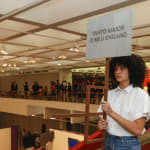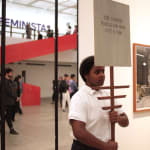
Ophelia, 2018
Performance in collaboration of Ana Mazzei.
MASP Collection
Performance during the exhibition “Knife in the Flesh”, Padiglione d’Arte Contemporanea, Milan, 2018

Ophelia, 2018
Performance in collaboration of Ana Mazzei.
MASP Collection
Performance during the exhibition “Knife in the Flesh”, Padiglione d’Arte Contemporanea, Milan, 2018

Ophelia, 2018
Performance in collaboration of Ana Mazzei.
MASP Collection
Performance during the exhibition “Knife in the Flesh”, Padiglione d’Arte Contemporanea, Milan, 2018

Ophelia, 2018
Performance in collaboration of Ana Mazzei.
MASP Collection
Performance during the exhibition “Knife in the Flesh”, Padiglione d’Arte Contemporanea, Milan, 2018

Ophelia, 2018
Performance in collaboration of Ana Mazzei.
MASP Collection
Performance during the exhibition “Feminist Histories”, MASP, Sao Paulo, 2019

Ophelia, 2018
Performance in collaboration of Ana Mazzei.
MASP Collection
Performance during the exhibition “Feminist Histories”, MASP, Sao Paulo, 2019

Ophelia, 2018
Performance in collaboration of Ana Mazzei.
MASP Collection
Performance during the exhibition “Feminist Histories”, MASP, Sao Paulo, 2019
Regina Parra & Ana Mazzei
Further images
-
(View a larger image of thumbnail 1
)

-
(View a larger image of thumbnail 2
)

-
(View a larger image of thumbnail 3
)

-
(View a larger image of thumbnail 4
)

-
(View a larger image of thumbnail 5
)

-
(View a larger image of thumbnail 6
)

-
(View a larger image of thumbnail 7
)

-
(View a larger image of thumbnail 8
)

Ophelia, of William Shakespeare’s Hamlet, gives title to this performance and installation by Ana Mazzei and Regina Parra. The figure of Ophelia became a symbol of a fragile and irrational femininity, being used as a reference to the also fictional disease of hysteria, created by the French doctor Jean-Martin Charcot (1825-1893) in the 19th century,
Ophelia became the exemplary image of the “crazy” woman, as opposed to the supposed rationality of the male characters in the Shakespearean tragedy. In the play, she is a young noblewoman, in love with the protagonist Hamlet, who finds herself in the midst of political and internal disputes that plague her mind and spirit, leading her to mental degradation and an iconic suicide ornamented by flowers and water—a scene that’s been widely represented in art history. But for Mazzei and Parra, it is not the morbid image of the female body carried by the waters that matters in Ophelia’s story, but the fragments of her monologues and dialogues, indexes of the progressive fraying of her subjectivity due to the condition of plaything to which she was subjected by men of your life.
Starting from this symbolic reference, the artists hold a silent march, in which nine women carry pieces of wood as signs, where selected fragments of Ophelia’s speeches are inscribed from the beginning to the end of the tragedy. Taken out of their original context, these phrases are confused with slogans, threats or signs of submission and dependence. In this kind of silent procession, wooden pieces sometimes make banners, sometimes battle shields. Some women display small objects that resemble bladed weapons, confrontation with the public feels imminent. The performance is at the threshold between the theater—one of the main references of the artists—and a political manifestation, in which the figure of Ophelia is re-enacted no longer as an alienated and passive character, but as a presence that returns to disturb the order patriarchal law.
Text by Isabella Rjeille, curator of the Museu de Arte de Sao Paulo (MASP). On the occasion of the exhibition Feminist Histories, MASP_Museum of Sao Paulo, Sao Paulo, 2019.
Exhibitions
Knife in the Flesh (2018), curated by Jacopo Crivelli Visconti at PAC_Padiglione d'Arte Contemporanea, Milan, Italy
Feminist Histories (2019), curated by Isabella Rjeille at MASP, Sao Paulo, Brazil
Literature
Women's histories, Feminist histories. Edited by: Mariana Leme, Adriano Pedrosa, Isabella Rjeille; curated by : "Women's Stories: Artists Until 1900" : Julia Bryan -Wilson, Lilia Moritz Schwarcz, Mariana Leme ; "Feminist Stories: Artists After 2000" : Isabella Rjeille ; textos: Matheus de Andrade [and 14 others]. São Paulo : MASP, Museu de Arte de São Paulo Assis Chateaubriand, 2018.
